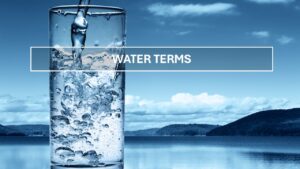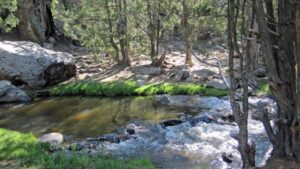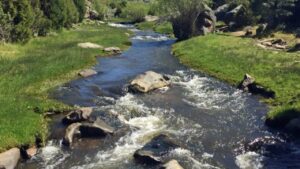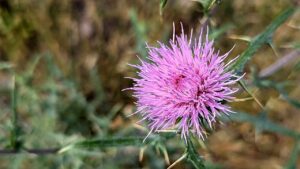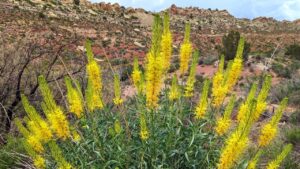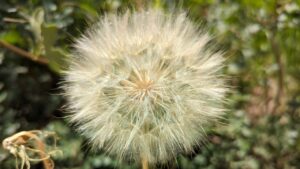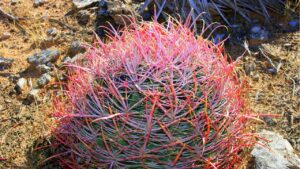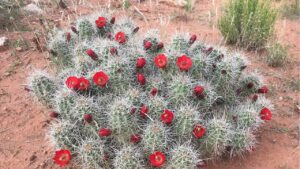Understanding Water & Land Use Terms
Updated: 04/2025
Every profession has specialized terms which are understood in that field. Below are water & land use terms with layman’s definitions (not legal definitions) we believe will help our customers to understand information presented by LDWA.
- Acre foot (AF) of water – a volume of water that covers one acre (about the size of a football field) to a depth of one foot, or 43,560 cubic feet, about 326,000 gallons.
- Aquifer – a natural underground area with layers of porous, water-bearing materials (sand, gravel) capable of yielding a supply of water; see Groundwater basin.
- Aquifer storage and recovery – the process of injecting potable water into an aquifer through wells or by surface spreading and infiltration and then pumping it out of the ground when needed. The aquifer essentially functions as a storage reservoir.
- Accessory Dwelling Unit (ADU) – is a secondary living space on the same property as a primary residence that offers independent living for one or more people.
- Backflow – a reverse flow condition, created by a difference in water pressures, which cause water to flow back into the distribution pipes/system of a potable water supply from any source(s) other than an intended source.
- Best management practices – methods or techniques found to be the most effective and practical means in achieving an objective. Often used in the context of water conservation.
- Blue Stakes – of Utah 811 is a free service that notifies utilities such as water, telephone, cable and sewer companies of pending excavations within the area (dial 8-1-1 at least 2 working days before you dig).
- Chlorine – a disinfectant added to water to destroy disease-causing bacteria and micro-organisms.
- Conjunctive use – the joint or alternating use of surface water and groundwater to more effectively manage water resources. Typically, during average or wet years, surface water is used in lieu of pumping groundwater, allowing the groundwater to remain for future use.
- Consumer Confidence Report (CCR) – released annually by July 1st, it is a report that provides information on water quality, constituents in the water, compliance with drinking water standards and educational material on tap water.
- Control valve – a device used to control the flow of water.
- Cross-connection – a connection between a drinking (potable) water system and a non-approved water source.
- Curb stop – a water service shutoff valve used to control water delivery located in a water service pipe near the curb and between the water main and the building.
- Department of Environmental Quality (DEQ) – is the state regulatory agency charged with implementing and enforcing state and federal environmental rules and regulations. The agency is made up of five divisions: Air Quality, Drinking Water, Environmental Response and Remediation, Waste Management and Radiation Control, & Water Quality.
- Direct Water Metering means a utility meter will be installed for each residential dwelling unit and the LDWA will monitor and bill the resident. The utility provider is responsible for calculating those usage charges and billing them directly to the property owner.
Billing: The property owner for each Water Company account receives a single bill for each billing period. - Distribution system – series of water pipelines connected together to form a network for the delivery of potable water for customer use and fire flow protection.
- Disinfectant – a chemical that destroys harmful micro-organisms.
- Division of Drinking Water (DDW) – acts as the administrative arm of the Utah Drinking Water Board. It implements the rules which they adopt. As such, it is engaged in a variety of activities related to the design and operation of Utah’s public drinking water systems.
- Drought – a period of below average rainfall causing water supply shortages.
- Environmental Protection Agency (EPA) – protects people and the environment from significant health risks, sponsors and conducts research, and develops and enforces environmental regulations.
- Equivalent Residential Connection (ERC) – means that measure of impact on public facilities equal to the impacts of one typical single-family detached dwelling unit in full time occupancy.
- Fire flow protection – the ability to have a sufficient quantity of water available to the distribution system to be delivered through fire hydrants or private fire sprinkler systems.
- Fluoride – is a naturally occurring element found in most water sources.
- Fluoridation – the addition of fluoride to drinking water to adjust the natural fluoride concentration found in water to the optimal level that provides the most benefit for dental health.
- Gallons per capita per day (GPCD) – a measurement of the average number of gallons of water use by the number of people served each day in a water system. The calculation is made by dividing the total gallons of water used each day by the total number of people using the water system.
- Groundwater basin – an underground body of water or aquifer defined by physical boundaries. In addition to using surface water, LDWA pumps groundwater from wells in the groundwater basin; see Aquifer.
- Groundwater recharge – the process of placing water in an aquifer. Can be a naturally occurring process or artificially enhanced.
- Hard water – water having a high concentration of minerals, typically calcium and magnesium ions.
- Human Dwelling – is a place where people live, such as a house, apartment, condo, tent, trailer, or igloo. In legal terms, a dwelling is a self-contained unit of accommodation that is used as a home by one or more households.
- Hydrologic cycle – the process of evaporation of water into the air and its return to earth in the form of precipitation (rain or snow). This process also includes transpiration from plants, percolation into the ground, groundwater movement, and runoff into rivers, streams and the ocean; see Water cycle.
- Mains, Distribution – a grid system of pipelines that delivers potable water from transmission mains to residential and commercial properties, usually pipe diameters of 4″ to 12″.
- Mains, Transmission – delivers potable water from a source, (i.e. groundwater or surface water), to a distribution grid system, usually pipe diameters of greater than 12″.
- Maximum Contaminant Level (MCL) – is the highest amount of a contaminant that is allowed in drinking water from a public water supply system.
- Maximum Contaminant Level Goal (MCLG) – is a non-enforceable public health goal that sets the maximum level of a contaminant in drinking water that is not expected to cause any known adverse health effects. The EPA sets MCLGs for each contaminant, and they are based solely on human health.
- Maximum day demand (MDD) – is calculated by multiplying the average day demand by a peaking factor. The peaking factor is the ratio between the average day demand and the maximum day demand, which is based on historical data.
- Maximum Residual Disinfection Level Goal (MRDLG) – is the maximum level of disinfectant that can be added to water during treatment without known or expected health effects. MRDLGs are non-enforceable health goals that allow for a margin of safety.
- Meter – a device capable of measuring, in either gallons or cubic feet, a quantity of water delivered by the water company to a service connection.
- Meter setter – a prefabricated brass/copper device used to connect a water meter to a water service line.
- Parcel – in Utah is a piece of land that is created by a legal description in a recorded document. The Recorder’s Office in Utah uses a unique number called a tax identification number, or parcel number, to represent each parcel of land. The parcel number is used for taxation and assessment purposes and appears on tax notices and plat maps.
- Peak day production requirement (MGD) – is a measurement of the maximum amount of water that a system can produce or demand on a given day:
- Calculation: The maximum day demand (MDD) is calculated by multiplying the average day demand by a peaking factor. The peaking factor is the ratio between the average day demand and the maximum day demand, which is based on historical data.
- Measurement: MGD is a measurement of water flow that is often used to measure water consumption. One MGD is equal to 133,680.56 cubic feet per day, 1.5472 cubic feet per second, or 3.0689 acre-feet per day.
- Pipeline – a line of connected piping that carries water, oil or other liquids.
- Pipeline, transmission – pipelines that transport treated water from its source (or raw water to a treatment plant) to a distribution system.
- Point of Responsibility, Metered Service – The connection point at the outlet side of the meter setter where a landowner’s responsibility for all conditions, maintenance, repairs, use and replacement of water service facilities begins, and the Water System’s responsibility ends.
- Point of Responsibility, Non-Metered Service – The connection point at the outlet side of either a curb stop or an unmetered meter setter where a landowner’s responsibility for all conditions, maintenance, repairs, use and replacement of water service facilities begins, and the water company’s responsibility ends.
- Potable water – water that is safe for human consumption. This generally means water that does not contain objectionable pollution, contamination, minerals or disease causing bacteria or viruses and is considered safe for drinking by the State Department of Public Health.
- Pressure reducing valve (PRV) – a device used to reduce the pressure in a domestic water system when the water pressure exceeds desirable levels.
- Pump station – a station where pumps are used to move water from one place to another or to lift water up to elevated locations.
- Reservoir – an area where water is stored to be used at a later time for peak demands or emergencies such as fire suppression.
- Runoff – water that travels downward over the earth’s surface due to the force of gravity. It includes water running in streams as well as over land.
- Sanitary Survey – All public drinking water systems are periodically inspected to assess their construction, operations, and record keeping. The inspections identify conditions that may present a sanitary or public health risk. Utah state regulations (R309-100-7) require that a sanitary survey be conducted at least every three years.
- Service connection – the water piping system connecting a customer’s system with a LDWA water main beginning at the outlet side of the point of responsibility, including all plumbing and equipment located on a parcel required for the LDWA’s provision of water service to that parcel.
- Smart irrigation controller – a device that automatically adjusts the time and frequency which water is applied to landscaping based on real-time weather such as rainfall, wind, temperature and humidity.
- Smart water monitors – attach to main water lines or appliances to track and transmit water usage data to a central hub or mobile app, allowing users to access detailed reports and alerts remotely.
- Source Protection Plan (SPP) – is a document that outlines actions to protect the quality of water sources that supply drinking water. SPPs can help to: Identify and mitigate threats to water quality, Improve the resilience of the water supply, Coordinate actions with partners, & investment from the public and government.
- Transpiration – the process by which water vapor is released into the atmosphere by living plants.
- Valve – a device that regulates, directs or controls the flow of water by opening, closing or partially obstructing various passageways.
- Water banking – the practice of actively storing or exchanging in-lieu surface water supplies in available groundwater basin storage space for later extraction and use by the storing party or for sale or exchange to a third party. Water may be banked as an independent operation or as part of a conjunctive use program.
- Water Capacity Unit (WCU) – measure the maximum amount of water that a container can hold when full. The units used to measure water capacity depend on whether the water is in motion or at rest, and the utility company that is measuring it:
- Gallon: A common unit of measurement for water.
Centum cubic feet (CCF): Also known as hundred cubic feet (HCF), this is a common unit used by water and natural gas utilities. One CCF is equal to 748 gallons. - Cubic foot: The volume of water that would fit in a container that is one foot wide, one foot long, and one foot deep.
- Acre-inch: The volume of water that would cover an acre (43,560 square feet) one inch deep.
- Acre-foot: The volume of water that would cover an acre one foot deep.
- Cubic feet per second (cfs): A unit used to measure water that is in motion.
- Ounces, cups, pints, quarts: Units used in the U.S. customary system of capacity measurement.
- Liter: The standard unit of capacity, with one liter equal to 1,000 milliliters.
- Gallon: A common unit of measurement for water.
- Water cycle – the continuous movement of water from the earth’s surface to the atmosphere and back again; see Hydrologic cycle.
- Water Master Meter – is a single meter that measures the total amount of water consumed by a building or complex. Master meters are commonly used in multi-unit residential and commercial properties, such as apartments, condominiums, and mobile home parks.
Billing: The property owner for each Water Company account receives a single bill for each billing period. - Water pressure – is created by the weight and elevation of water and/or generated by pumps that deliver water to the tap.
- Water service line – delivers potable water to a residence or business from the LDWA’s water system. Typically, the water service line is a ¾” to 2″ diameter pipe for residential properties.
- Watershed – the region or land area that contributes to the drainage or catchment area above a specific point on a stream or river.
- Water Submetering – is an alternative to master metering, where the property owner installs individual meters for each additional building or complex unit. This allows for the exact measurement of water consumption by each unit. This allows property owners to accurately track water usage and charge each tenant based on their consumption. The installation of additional meters and plumbing is the responsibility of the parcel owner and need to meet all Town Land Use Ordinances and State Plumbing Code.
Billing: The property owner for each Water Company account receives a single bill for each billing period, which includes the usage through any submeter installed on their parcel. If the property owner has submeters to track tenant water usage, they may include this utility expense in their rental contract or divide the bill among tenants. - Water supply fixture units (WSFUs) – are a way to estimate how much water a building will need, and are used to size water piping systems. WSFUs are not a measurement unit, but rather an assigned value that takes into account how often a fixture is used, how much water it needs, and how that water is used.
- Water table – the upper surface of the zone of saturation of groundwater in an unconfined aquifer.
- Water transfer – a transaction, in which a holder of a water right or entitlement voluntarily sells/exchanges to a willing buyer the right to use all or a portion of the water under that water right or entitlement.
- Water-Wise House Call – a service which provides a custom evaluation of a customer’s indoor and outdoor water use and landscape watering requirements.
- Well – a hole drilled into the ground to tap an underground aquifer.
- Wetlands – lands which are fully saturated or under water at least part of the year, like seasonal vernal pools or swamps.
